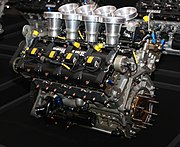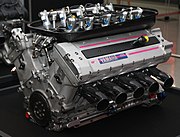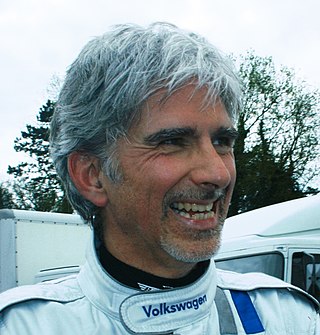
Damon Graham Devereux Hill, is a British former professional racing driver from England and the 1996 Formula One World Champion. He is the son of Graham Hill, and, along with Nico Rosberg, one of two sons of a Formula One World Champion to also win the title. He started racing on motorbikes in 1981, and after minor success moved on to single-seater racing cars.

A straight-four engine is a four-cylinder piston engine where cylinders are arranged in a line along a common crankshaft.

Renault, a French automobile manufacturer, has been associated with Formula One as both team owner and engine manufacturer for various periods since 1977. In 1977, the company entered Formula One as a constructor, introducing the turbo engine to Formula One with its EF1 engine. In 1983, Renault began supplying engines to other teams. Although the Renault team had won races, it withdrew at the end of 1985. Renault engines continued to be raced until 1986.
Yamaha Motor Co., Ltd. is a Japanese mobility manufacturer that produces motorcycles, motorboats, outboard motors, and other motorized products. The company was established in the year 1955 upon separation from Nippon Gakki Co., Ltd. and is headquartered in Iwata, Shizuoka, Japan. The company conducts development, production and marketing operations through 109 consolidated subsidiaries as of 2012.

The Hungarian Grand Prix is a motor racing event held annually in Mogyoród at the Hungaroring. Since 1986, the race has been a round of the FIA Formula One World Championship.

The DFV is an internal combustion engine that was originally produced by Cosworth for Formula One motor racing. The name is an abbreviation of Double Four Valve, the engine being a V8 development of the earlier four-cylinder FVA, which had four valves per cylinder.
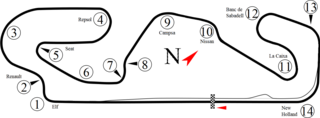
The 1994 Spanish Grand Prix was a Formula One motor race held on 29 May 1994 at the Circuit de Catalunya, Montmeló. It was the 36th Spanish Grand Prix and the fourth to be held at the Circuit de Catalunya, and the fifth race of the 1994 Formula One World Championship.

The 1997 Australian Grand Prix was a Formula One motor race held at the Albert Park Circuit in Melbourne on 9 March 1997. It was the first race of the 1997 Formula One World Championship, and the second Australian Grand Prix to be held in Melbourne.
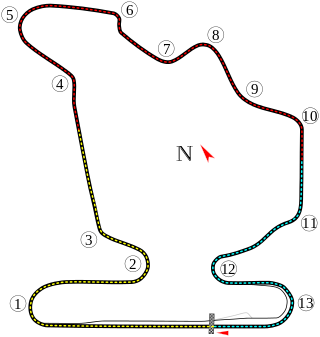
The 1997 Hungarian Grand Prix was a Formula One motor race held at Hungaroring, Mogyoród, Pest, Hungary on 10 August 1997. The race, contested over 77 laps, was the eleventh race of the 1997 Formula One season and was won by Jacques Villeneuve, driving a Williams-Renault, with Damon Hill second in an Arrows-Yamaha and Johnny Herbert third in a Sauber-Petronas.

The 1997 FIA Formula One World Championship was the 51st season of FIA Formula One motor racing. It commenced on 9 March and ended on 26 October after seventeen races. The Drivers' Championship was won by Jacques Villeneuve and the Constructors' Championship was awarded to Williams-Renault.

The 1996 FIA Formula One World Championship was the 50th season of FIA Formula One motor racing. The championship commenced on 10 March and ended on 13 October after sixteen races. Two World Championship titles were awarded, one for Drivers and one for Constructors.
Mecachrome SAS is a precision engineering company based in France that operates in the aerospace, motor racing, energy and defence sectors.

Judd is a brand of racing car engines built by Engine Developments Ltd., a company founded in 1971 by John Judd and Jack Brabham in Rugby, Warwickshire, England. Engine Developments was intended to build engines for Brabham's racing efforts, and became one of the first firms authorised by Cosworth to maintain and rebuild its DFV engines, but has since expanded into various areas of motorsport.

The Arrows A18 was the car with which the Arrows Formula One team competed in the 1997 Formula One World Championship. It was driven by Briton Damon Hill, the reigning World Champion who had made the surprising move to the team after being dropped by Williams, and Brazilian Pedro Diniz, who had moved from Ligier.
This article gives an outline of Formula One engines, also called Formula One power units since the hybrid era starting in 2014. Since its inception in 1947, Formula One has used a variety of engine regulations. "Formulae" limiting engine capacity had been used in Grand Prix racing on a regular basis since after World War I. The engine formulae are divided according to era.
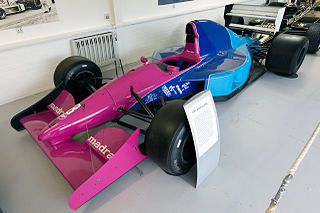
The Brabham BT60 was the final series of Formula One racing cars built for the Brabham Formula One motor racing team. Designed by Sergio Rinland, they raced in the 1991 and 1992 Formula One World Championships. The car brought to a close Brabham's 30 years of construction of purpose-built racing cars, which began with Jack Brabham and Ron Tauranac and the Brabham BT1 Formula Junior design in 1961.

Michael "Herbie" Blash is the Permanent Senior Advisor to the FIA Race Directors at Formula One races.
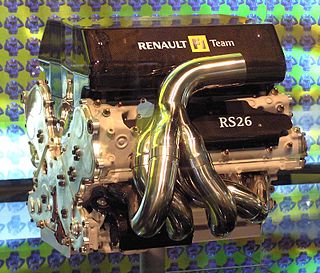
The RS series is a family of naturally-aspirated Grand Prix racing engines, designed, developed and manufactured jointly by Mecachrome and Renault Sport for use in Formula One, and used by Arrows, BAR, Williams, Ligier, Lotus, Caterham, Benetton, Renault, and Red Bull, from 1989 until 2013. The engines came in both the original V10, and later V8 configurations, and engine displacement ranged from 2.4 L (150 cu in) to 3.5 L (210 cu in) over the years. Power figures varied; from 650 hp (480 kW) @ 12,500 rpm, to later over 900 hp (670 kW) @ 19,000 rpm. The 2.4-litre RS26 V8 engine, used in 2006, is one of the highest revving Formula One engines in history, at 20,500 rpm. Between 1998 and 2000, the RS9 engines were badged as Mecachrome, Supertec, and Playlife.
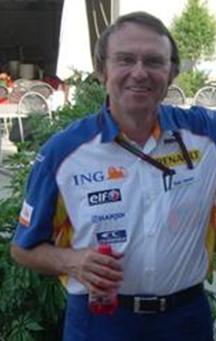
Denis Chevrier is a retired Formula One engineer who was the head of engine operations for the Renault F1 team from 2002 to 2007.

